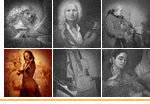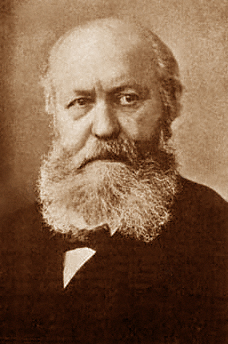PIECE: AVE MARIA FROM A THEME BY J. S. BACH
SECTION 4.13
| Ave Maria from a Theme by J. S. Bach |
Charles-François Gounod (1818-1893), a French composer, was responsible for the piece Ave Maria from a theme by J.S. Bach. Gounod's father was an artist and engraver for royalty, and his mother was an accomplished pianist. Gounod studied music at the Paris Conservatoire, and was the winner of prestigious musical competitions such as the Prix de Rome (he won the Grand Prix de Rome in 1839).
Gounod's musical setting of Ave Maria is based on the "First Prelude in C major" from Book I of the Well-Tempered Clavier (BWV 846) by Johann Sebastian Bach. Gounod composed a melody (a descant), and superimposed it on Bach's C major prelude. Although the text Ave Maria (a Latin prayer used by the Catholic Church), is often used with this piece, one of the first texts which Gounod used with his melody, was a poem by the French poet Lamartine. Gounod wrote the following version using the Lamartine poem in 1852: Meditation on the First Prelude of J. S. Bach (Lamartine: Vers sur un album). It is likely that Gounod used the descriptive term Meditation to describe the reflective nature of his melody, and the peaceful, meditative feeling of the piece. Gounod arranged another version in 1853 (for violin or cello and piano), and it wasn't until 1859 that he applied the Ave Maria text to his music. Other words have been adapted to this melody, but the text of Ave Maria is one of the most popular. This piece is sometimes called Ave Maria by Bach-Gounod because of the contributions of both Bach and Gounod in creating this lovely work. [32]
The following quote describes what may have inspired Gounod to use the music of Bach as the basis of his piece:
He [Gounod] was a familiar guest of two ladies of fine mind and superior talent—Mme. Viardot (Pauline A. Garcia)…and Fanny Hensel, Mendelssohn's sister, who revealed to him the beauties of Bach and Beethoven, and inspired him to transports of admiration…It was probably not long after one of these intimate recitals, in whose course Fanny Hensel introduced Gounod to Bach, that the former composed, on the harmonious weft of the first prelude in The Well-tempered Clavichord, the fine melody of the Meditation, which helped to establish his juvenile renown. This Meditation has been made into an Ave Maria, and people have gone into ecstasies over his religious feeling. This is a total misconception; this melody has been successively adapted to very different sets of words, and it was conceived quite independently of any preconception other than musical; it is a 'counter-subject' naturally emanating from Bach's prelude, in whose harmonies it was integrally contained. To disengage it, artistic insight was needed; Gounod executed this contrapuntal operation in masterly fashion; but he did it simply as an artist. [33]
TECHNIQUE TIPS: Gounod's lyrical melody is in a flowing, sustained line. Use smooth bows, slur when needed, and carefully phrase the music. Note the use of accents in measure 32. An accent is indicated by the sign > (placed over or under a note) and means the note should be emphasized by adding pressure with the bow. This effect is used in measure 32 to express passion and emotion.
© Copyright 2024 RK Deverich. All rights reserved.
*Although this online viola class is provided free of charge, all rights are reserved and this content is protected by international copyright law. It is illegal to copy, post or publish this content in any form, and displaying any of this material on other websites, blogs or feeds is prohibited. Permission is given for individual users to print pages from this website for their personal, non-commercial use.



